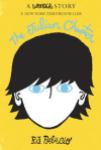 While reading Wonder, I wondered: Why did the author, R.J. Palacio, exclude the perspective of Julian, the boy who “bullies” the main character Auggie Pullman? Auggie narrates his story of starting school for the first time, as a fifth grader, with a severe craniofacial abnormality. We also hear his story from the perspective of other young characters (friends, sibling, sibling’s friends) who care about him. Told in chapters of their own, their perspectives add sensitivity and movement. Why don’t we hear from the bully? Is there a backstory that explains his behavior without condoning it? Continue reading Light on Wonder’s Shadow (2 of 2)
While reading Wonder, I wondered: Why did the author, R.J. Palacio, exclude the perspective of Julian, the boy who “bullies” the main character Auggie Pullman? Auggie narrates his story of starting school for the first time, as a fifth grader, with a severe craniofacial abnormality. We also hear his story from the perspective of other young characters (friends, sibling, sibling’s friends) who care about him. Told in chapters of their own, their perspectives add sensitivity and movement. Why don’t we hear from the bully? Is there a backstory that explains his behavior without condoning it? Continue reading Light on Wonder’s Shadow (2 of 2)
Category Archives: Spiritual Growth for Kids
WONDER, The Book (1/2)
 Wonder, the New York Times #1 bestseller by R.J. Palacio, engages readers in the world of August Pullman, a fifth grader whose appearance tests the limits of “othering,” turning someone who is different into an “other.” Having home-schooled his whole life, Auggie enters school for his first time while his classmates face his craniofacial abnormality for their first time. Layers of bullying ravel and unravel revealing the potential within each of us for either escalating ill-will or good-will. Each layer ups the ante.
Wonder, the New York Times #1 bestseller by R.J. Palacio, engages readers in the world of August Pullman, a fifth grader whose appearance tests the limits of “othering,” turning someone who is different into an “other.” Having home-schooled his whole life, Auggie enters school for his first time while his classmates face his craniofacial abnormality for their first time. Layers of bullying ravel and unravel revealing the potential within each of us for either escalating ill-will or good-will. Each layer ups the ante.
Poly-rhythm, Inter-spiritual
 Given my perhaps naive belief that interfaith orientations and integral philosophies are part of humanity’s next evolutionary step in spiritual development, I wondered what kind of music would show up in our culture to reflect this transition in consciousness? Then I turned on the radio and, Voila!
Given my perhaps naive belief that interfaith orientations and integral philosophies are part of humanity’s next evolutionary step in spiritual development, I wondered what kind of music would show up in our culture to reflect this transition in consciousness? Then I turned on the radio and, Voila!
NPR was doing a story on polyrhythms or many rhythms happening at the same time “creating a different shape in the sound”. One example of a polyrhythm is Fake Empire which played during an Obama 2008 election campaign ad. It has two simultaneous beats, 3 and 4. There are plenty of songs with polyrhythms and while it’s not something totally new, we might ask: How can polyrhythms help us develop spiritually?
“The point of [polyrhythm] is to make listening to two rhythms at once feel natural, as easy as talking while you walk. LaFrae Sci says, that’s a life skill.”
Here’s my analogy: If we can learn to hear two or more rhythms simultaneously in music, we can learn to empathize with two or more belief systems simultaneously. Doing so might help us to hear the many sides of a story, appreciate the different points of views in a conflict, and even feel comfortable with learning about and from more than one religion. We might even develop the social equivalent of harmony – justice. In other words, polyrhythms could very well accompany an expansion of consciousness.
You can read here how I teach youth to hold and harmonize multiple ideas about faith, identity, and community so that they will have the life skills to solve practical, global problems with peers from many faiths and cultures for the benefit of all humanity. That may be a tall order. But at the very least, polyrhythms ask us to change the way we listen to music. In the process, they might help us to change the way we listen to each other.
Explore the Resources my this website to learn more about interspiritual ideas and programs.
TWICE “FROZEN”
 I had a chance to see FROZEN again and it was even better the second time. So this blog follows the first, “Frozen” and Sacrifice. What struck me this time was the contrast between Elsa, the older sister with the power to freeze things, and Olaf, the little snowman she creates along way. The first time I saw the film, Olaf seemed like a comical, secondary character, and at times, an interruption to the plot. Why did Disney give him so much attention? He even gets to sing a solo about his desire to experience summer. But watching it this time, I saw how incredibly central Olaf is to the moral of the story. Olaf is the ying to Elsa’s yang. Continue reading TWICE “FROZEN”
I had a chance to see FROZEN again and it was even better the second time. So this blog follows the first, “Frozen” and Sacrifice. What struck me this time was the contrast between Elsa, the older sister with the power to freeze things, and Olaf, the little snowman she creates along way. The first time I saw the film, Olaf seemed like a comical, secondary character, and at times, an interruption to the plot. Why did Disney give him so much attention? He even gets to sing a solo about his desire to experience summer. But watching it this time, I saw how incredibly central Olaf is to the moral of the story. Olaf is the ying to Elsa’s yang. Continue reading TWICE “FROZEN”
“FROZEN” and Sacrifice
 I finally saw FROZEN, the 2014 Oscar Winner for Animated Feature Film, in-flight on my way to an interspiritual conference via a visit to my sister. (How apropos.) So sisterhood and spirituality were on my mind. The movie was as good as my 15 year old daughter said it was – she saw it twice. Indeed, I was pleasantly surprised when Disney broke from a predictable storyline for new territory. The film demonstrates the value and meaning of sacrifice by contrasting it in two forms; one true and one false. Continue reading “FROZEN” and Sacrifice
I finally saw FROZEN, the 2014 Oscar Winner for Animated Feature Film, in-flight on my way to an interspiritual conference via a visit to my sister. (How apropos.) So sisterhood and spirituality were on my mind. The movie was as good as my 15 year old daughter said it was – she saw it twice. Indeed, I was pleasantly surprised when Disney broke from a predictable storyline for new territory. The film demonstrates the value and meaning of sacrifice by contrasting it in two forms; one true and one false. Continue reading “FROZEN” and Sacrifice
Jewish Identity, Again?
 The New York Times today (1 Oct 2013) posted the results of the first major survey of American Jews in over a decade conducted by the Pew Research Center’s Religion & Public Life Project. The data are not that surprising. But the conclusions confound me.
The New York Times today (1 Oct 2013) posted the results of the first major survey of American Jews in over a decade conducted by the Pew Research Center’s Religion & Public Life Project. The data are not that surprising. But the conclusions confound me.
Data show that intermarriage continues to rise and that fewer Jews raise their children with a Jewish identity. “Of the “Jews of no religion” who have children at home, two-thirds are not raising their children Jewish in any way. This is in contrast to the “Jews with religion” of whom 93 percent said they are raising their children to have a Jewish identity.” The conclusion is that “this secular trend has serious consequences for what Jewish leaders call Jewish continuity.” Which leaders? What do they mean “not Jewish in any way”? Is Jewish identity and continuity really threatened, or only these leaders’ idea of it? What if identity consisted of another idea?